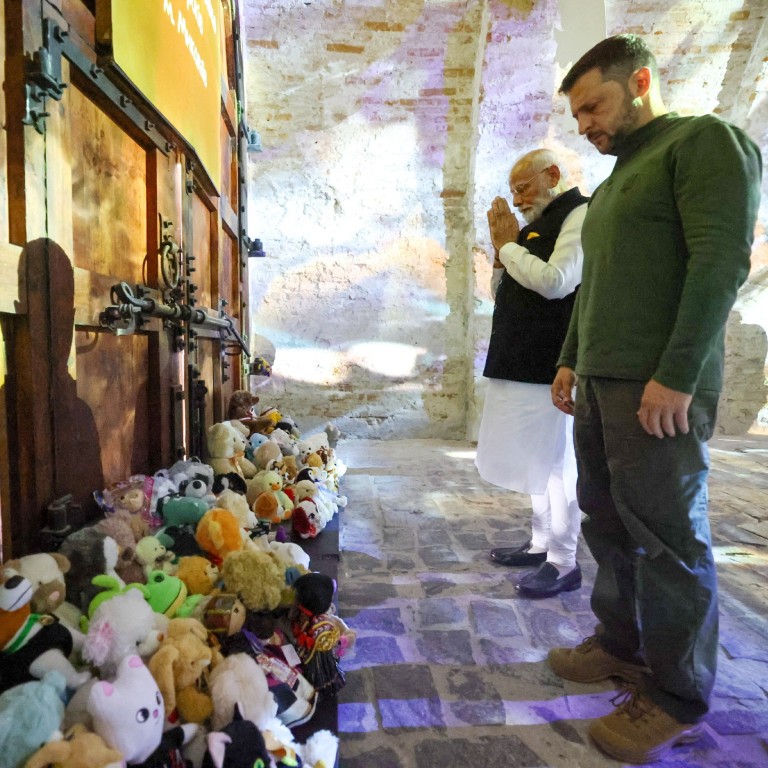
What Modi’s historic Ukraine trip means for India’s peacemaker role, Russia ties
- The Indian prime minister’s visit marks a milestone, but New Delhi’s Moscow links will hamper its ability to influence the conflict
Yet for all the fanfare, analysts were quick to temper expectations, describing Modi’s role as a peacemaker as “limited” and unlikely to fundamentally alter the New Delhi- Moscow relationship.

According to India’s Ministry of External Affairs, during Friday’s meeting Modi and Zelensky discussed Ukraine’s peace plan, which centres on restoring the country’s territorial integrity and the withdrawal of Russian troops.
“We say it very loudly and clearly that we support the respect for sovereignty and territorial integrity,” Modi said.
While the specific agreements signed between India and Ukraine on medical, agricultural, humanitarian and cultural cooperation were “obviously significant”, according to Richard Rossow, a senior adviser at the Washington-based Centre for Strategic and International Studies, the Indian leader’s gestures carried greater symbolic weight.
“The signalling effect of visiting the Martyrologist exhibition on children [who have lost their lives in the conflict with Russia] at the National Museum of History of Ukraine was significant too,” Rossow said, pointing to Modi’s earlier comments to Putin that his “heart bleeds” when hearing of the young people killed in the invasion.
Modi and Zelensky also agreed on a joint statement affirming their commitment to developing a strategic partnership – a move analysts saw as India’s effort to balance its long-standing ties with Moscow while engaging more deeply with Kyiv.
After visiting the Martyrologist Exposition, Modi took to social media to express his anguish, posting on X that “conflict is particularly devastating for young children” and that his heart “goes out to the families of children who lost their lives, and I pray that they find the strength to endure their grief”.
While India maintains close links with Russia, Rossow cautioned “any chance for Prime Minister Modi to play a role in brokering peace will be driven by Russia’s timeline”, adding that his influence was “likely limited”.
“When the time comes that Russia is ready to negotiate some type of settlement, India could play an important role due to its close ties with all major players, even Ukraine, to some extent,” he said.
Xiaoyu Pu, an associate professor of political science at the University of Nevada in Reno, struck a similar note, describing Modi’s role as “positive but limited” and arguing that the Indian leader’s visit had done little to position his country in a more neutral stance.
“India still values its cooperation and partnership with Russia,” Pu said, characterising the trip as more of a “balanced diplomatic gesture”.

While Modi’s diplomatic outreach had reassured the West “to some degree”, Pu said Western countries should also “realistically acknowledge” that India’s strategic ties with Russia are likely to remain strong.
This is driven by India’s need for strategic autonomy, defence cooperation, and energy imports from Moscow – factors that make it highly unlikely that India will shift away from Russia, he said.
“These deep-rooted ties will likely remain unchanged, as India’s approach remains pragmatic and focuses on maintaining multiple global partnerships without compromising its interests,” Pu said.
This sentiment was echoed in India’s response to recent remarks by US Ambassador Eric Garcetti, who had suggested there was “no such thing as strategic autonomy” in times of conflict. Delhi swiftly retorted that it “values its strategic autonomy” – a clear affirmation of its intention to chart an independent course.
India’s defence industries remain heavily dependent on Russian equipment and technology, despite efforts to diversify its purchases. Just last month, Russia’s state export company Rostec signed an agreement to manufacture advanced armour-piercing “Mango” tank shells in India for the T-90 tank.
Russian oil also continues to make up a growing share of India’s imports, reaching a record 44 per cent of the country’s overall oil purchases in July. At 2.07 million barrels per day, this represents a 12 per cent increase from a year ago, according to trade and industry data.

Swaran Singh, a professor of diplomacy and disarmament at Delhi’s Jawaharlal Nehru University, said Modi’s visit to Ukraine had showcased India’s “strategic autonomy” and “proactive neutrality” in the ongoing crisis.
He said the visit had also brought “relief to over 2,500 Indians in Ukraine” who had faced the “anger of Ukrainians” due to India’s proximity to Russia and its refusal to condemn Moscow’s “special military operations” over the past two-and-a-half years.
Contrary to some misconceptions, Singh clarified that Modi’s visit was not primarily aimed at assuaging Western powers’ dissatisfaction with India’s earlier trip to Moscow. Instead, he said that India’s shift from non-alignment to multi-alignment over the past two decades had resulted in a reduction of its military procurements from Russia, from 65 per cent to 46 per cent, as it sought to diversify its partnerships.
“So while India’s defence and energy procurements from Russia will continue to be substantive, [its] expanding partnerships will see Modi’s Ukraine visit becoming an inflection point in India evolving an important economic and defence partnership with Kyiv as well,” Singh said.
However, Kanchi Mathur, a geopolitical risk analyst focused on the Indo-Pacific region, noted that Ukraine’s Zelensky had “clearly” expressed dissatisfaction with Delhi’s continued economic support for Russia, stating that if India were to stop importing Russian oil, the war will end as “Putin and his society will feel the pain of war”.
Modi’s trip to Ukraine shows that just because India maintains a “long-term strategic and economic partnership with Russia, does not mean that it does not see value in nurturing its bilateral relationship with US allies and partners,” she said.


